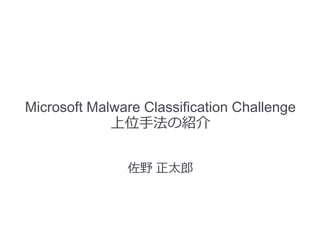Microsoft Malware Classification Challenge 上位手法の紹介 (in Kaggle Study Meetup)
- 1. Microsoft Malware Classification Challenge 上位手法の紹介 佐野 正太郎
- 2. アジェンダ ? コンペ概要 ? ベースラインアプローチ ? ワードカウント & ランダムフォレスト ? 上位手法の紹介 ? 特徴抽出 ? 特徴変换 ? 分类器 ? 优胜チームのモデル
- 3. コンペ概要
- 6. コンペ概要 .bytes Your Model Malware Class Probabilities .asm 10,868training samples 1,000GB in total 9classes 10,873 test samples
- 7. コンペ概要 ? クラス毎の確率を各サンプルに対して出力 ? モデル評価:Log Loss ?? ? ? ? ? ?? 1 0 1 0 ,,log log 1 N i K k kiki py N L
- 8. ベースラインアプローチ
- 9. ベースラインアプローチ ? Beat the benchmark (~0.182) with RandomForest [4] ? ヘキサダンプからワードカウント特徴量抽出 ? 1バイト=1単語 ? そのままランダムフォレストに投げる .bytes Random Forest Classifier 1-byte Word Count Malware Classes Probabilities
- 10. ベースラインアプローチ ? コンペ初期からフォーラムに登場 ? It was a surprise that one can achieve the accuracy of 0.96 just by using counts of ‘00’and, ‘FF’, and ‘??’. [3]
- 11. 特徴抽出
- 12. 上位勢の特徴抽出 ? ヘキサダンプからのワードカウント ? 逆アセンブリからのワードカウント ? ハイブリッドワードカウント ? ファイルのメタデータ ? テクスチャ画像
- 13. ヘキサダンプからのワードカウント ? 1バイトを1単語として扱う ? Nグラムモデルで性能が向上 ? 优胜チームのモデルでは4グラムまで取得 ? 1ラインを1単語とする方法も [2]
- 18. ハイブリッド特徴量 ? DAF (Derived Assembly Features) 特徴量 [6] (1) ヘキサダンプからNグラム特徴量抽出 (2) (1)を情報ゲインで絞り込み (3) (2)と共起するアセンブリインストラクションを抽出 (4) (3)を情報ゲインで絞り込み ヘキサダンプ特徴が 重要な場合のみ インストラクションを 特徴としてカウント
- 19. ファイルのメタデータ ? ヘキサダンプファイルのサイズ ? 逆アセンブリファイルのサイズ ? ヘキサンダンプファイルの圧縮レート ? 逆アセンブリファイルの圧縮レート ? etc.
- 20. テクスチャ画像 ? ヘキサダンプをグレースケール画像に変換 ? 1バイト=1画素値 ? 適当な画像特徴量を抽出 ? 元論文ではGIST特徴量を使用[7]
- 23. 特徴変换
- 24. 上位勢の特徴変换 ? TF-IDF ? 情報ゲイン ? 非負値行列因子分解 ? ランダムフォレスト
- 25. TF-IDF ? 単語頻度をドキュメント長で正規化 ? 小数のドキュメントにしか出現しない単語を強調 idftftfidf *? ? ? ? docword worddoc docword docword tf ' , }in'{# }in{# }includingdocs{# docs}all{# log word idfword ?
- 26. 情報ゲイン ? ある特徴を既知とした場合のエントロピーの差分 ? 計算の簡単化 ? 単語の頻度 => 出現したかどうかの二項値 ? クラス毎に独立して特徴を選択 )|()()( xYHYHxGain ?? ))(log)(log( )log()(log)( 22 }1,0{ 2 v v v v v v v v v v t n t n t p t p t t t n t n t p t p xGain ??? ??? ?? ポジティブサンプル数 ネガティブサンプル数 トータルサンプル数 対象特徴を固定した場合のサンプル数
- 27. 非負値行列因子分解 ? Nグラムワードカウントは多次元な非負値行列 ? 非負値の特性を保ったまま次元圧縮 ? 非負値行列を非負値行列の積に分解 ? 下の例では5次元から2次元に圧縮 ?? ? ? ?? ? ? ? ? ? ? ? ? ? ? ? ? ? ? ? ? ? ? ? ? ? ? ? ? ? ? ? ? ? ? ? 20011 01210 13 00 21 01 23641 00000 41232 01210
- 28. ランダムフォレスト ? 分类器ではなく特徴選択手法として利用 ? 学習後にFeature 滨尘辫辞谤迟补苍肠别の低い特徴を捨てる
- 29. 分类器
- 30. XGBoost ? 高速?多機能な勾配ブースティングの実装 ? アンサンブル木学習 + 勾配法 ? 勾配法の要領で逐次的に弱い木を学習 ))(,()()( 1 1 1 xFyLxFxF ti n i Fttt ? ? ? ???? ? 前ステップまでに 学習したフォレスト 次ステップの木は 前ステップの負勾配にフィット
- 31. Averaging ? 複数モデル出力の単純平均をサブミットする ? 幾何平均で性能が向上することも ? Averaging multiple different green lines should bring us closer to the black line. [5]
- 34. 优胜チームのモデル
- 35. Opcode 2-gram Opcode 3-gram Opcode 4-gram Header 1-gram Hexdump 4-gram & Info Grain DAF 1-gram DLL 1-gram Random Forest XGBoost Assembly Texture Image Instruction 1-gram Hexdump 1-gram Random Forest Semi-supervised Learning with Test Dataset Averaging
- 36. Opcode 2-gram Opcode 3-gram Opcode 4-gram Header 1-gram Hexdump 4-gram & Info Grain DAF 1-gram DLL 1-gram Random Forest XGBoost Assembly Texture Image Instruction 1-gram Hexdump 1-gram Random Forest Semi-supervised Learning with Test Dataset Averaging
- 38. テストデータを含めた半教師あり学習 ? トレーニングデータでモデル学習(中間モデル) ? 中間モデルで全テストデータをラベル付け ? ラベル付きテストデータを複数のチャンクに分割 ? 各チャンクに対し: ? 対象チャンク以外のトレーニングデータとラベル付き テストデータで最終モデルを学習 ? 最終モデルで対象チャンクのクラス確率を予測 ? 各チャンクの結果を統合
- 39. Opcode 2-gram Opcode 3-gram Opcode 4-gram Header 1-gram Hexdump 4-gram & Info Grain DAF 1-gram DLL 1-gram Random Forest XGBoost Assembly Texture Image Instruction 1-gram Hexdump 1-gram Random Forest Semi-supervised Learning with Test Dataset Averaging
- 40. Opcode 2-gram Opcode 3-gram Opcode 4-gram Segment 1-gram Hexdump 4-gram & Info Grain DAF 1-gram DLL 1-gram Random Forest XGBoost Assembly Texture Image Instruction 1-gram Hexdump 1-gram Random Forest Semi-supervised Learning with Test Dataset Averaging Golden Features
- 41. どの特徴が効いていたか? 0 0.002 0.004 0.006 0.008 0.01 0.012 0.014 0.016 Opcode-count Opcode Count Segment Count Opcode Count Segment Count ASM Texture All Features Cross Validation Public Leaderboard Private Leaderboard Log-loss
- 45. Thank you!
- 46. リファレンス 1. First place code and documents ? https://www.kaggle.com/c/malware- classification/forums/t/13897/first-place-code-and-documents 2. 2nd place code and documentation ? https://www.kaggle.com/c/malware- classification/forums/t/13863/2nd-place-code-and-documentation 3. 3rd place code and documentation ? https://www.kaggle.com/c/malware- classification/forums/t/14065/3rd-place-code-and-documentation
- 47. リファレンス 4. Beat the benchmark (~0.182) with RandomForest ? https://www.kaggle.com/c/malware-classification/forums/t/12490/beat- the-benchmark-0-182-with-randomforest 5. Kaggle Ensembling Guide ? http://mlwave.com/kaggle-ensembling-guide
- 48. リファレンス 6. Masud, M. M., Khan, L., and Thuraisingham, B., “A Scalable Multi-level Feature Extraction Technique to Detect Malicious Executables,” Information Systems Frontiers, Vol. 10, No. 1, pp. 33-45, (2008). 7. Nataraj, L., Yegneswaran, V., Porras, P. and Zhang, J. “A Comparative Assessment of Malware Classification Using Binary Texture Analysis and Dynamic Analysis,” Proceedings of the 4th ACM Workshop on Security and Artificial Intelligence, 21-30 (2011).









![ベースラインアプローチ
? Beat the benchmark (~0.182) with RandomForest [4]
? ヘキサダンプからワードカウント特徴量抽出
? 1バイト=1単語
? そのままランダムフォレストに投げる
.bytes
Random
Forest
Classifier
1-byte
Word
Count
Malware
Classes
Probabilities](https://image.slidesharecdn.com/kagglestudymeetupmicrosoftmalwareclassificationchallenge-160213141110/85/Microsoft-Malware-Classification-Challenge-in-Kaggle-Study-Meetup-9-320.jpg)
![ベースラインアプローチ
? コンペ初期からフォーラムに登場
? It was a surprise that one can achieve the accuracy of
0.96 just by using counts of ‘00’and, ‘FF’, and ‘??’. [3]](https://image.slidesharecdn.com/kagglestudymeetupmicrosoftmalwareclassificationchallenge-160213141110/85/Microsoft-Malware-Classification-Challenge-in-Kaggle-Study-Meetup-10-320.jpg)


![ヘキサダンプからのワードカウント
? 1バイトを1単語として扱う
? Nグラムモデルで性能が向上
? 优胜チームのモデルでは4グラムまで取得
? 1ラインを1単語とする方法も [2]](https://image.slidesharecdn.com/kagglestudymeetupmicrosoftmalwareclassificationchallenge-160213141110/85/Microsoft-Malware-Classification-Challenge-in-Kaggle-Study-Meetup-13-320.jpg)




![ハイブリッド特徴量
? DAF (Derived Assembly Features) 特徴量 [6]
(1) ヘキサダンプからNグラム特徴量抽出
(2) (1)を情報ゲインで絞り込み
(3) (2)と共起するアセンブリインストラクションを抽出
(4) (3)を情報ゲインで絞り込み
ヘキサダンプ特徴が
重要な場合のみ
インストラクションを
特徴としてカウント](https://image.slidesharecdn.com/kagglestudymeetupmicrosoftmalwareclassificationchallenge-160213141110/85/Microsoft-Malware-Classification-Challenge-in-Kaggle-Study-Meetup-18-320.jpg)

![テクスチャ画像
? ヘキサダンプをグレースケール画像に変換
? 1バイト=1画素値
? 適当な画像特徴量を抽出
? 元論文ではGIST特徴量を使用[7]](https://image.slidesharecdn.com/kagglestudymeetupmicrosoftmalwareclassificationchallenge-160213141110/85/Microsoft-Malware-Classification-Challenge-in-Kaggle-Study-Meetup-20-320.jpg)










![Averaging
? 複数モデル出力の単純平均をサブミットする
? 幾何平均で性能が向上することも
? Averaging multiple different green lines should bring us
closer to the black line. [5]](https://image.slidesharecdn.com/kagglestudymeetupmicrosoftmalwareclassificationchallenge-160213141110/85/Microsoft-Malware-Classification-Challenge-in-Kaggle-Study-Meetup-31-320.jpg)
















